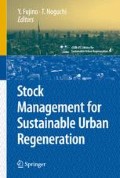A city as a spatial expanse includes people as well as different natural and artif icial elements. Let us regard the entirety of such a city as “the urban environment”: a stage for human lives, including its space and all the elements within. To classify these various elements is basic to considering and preserving the urban environment, though there are different ways of classification depending on one's purpose. If one intends to build, for example, such elements should be considered as civil engineering works, architecture, other artificial urban constituents, and nature, which correspond respectively to the academic fields of civil engineering, architecture, urban engineering, and landscape design. Such classification, however, cannot cover other inherent urban elements such as air and water, and wastes that are discharged by our urban activities
Therefore, for the purpose of this program that intends to cover all the elements within the urban environment and to manage their sustainable development, it should better suit us to adopt a new viewpoint in which these elements can be regarded as usable “resources,” leaving aside the established academic structure.
Access this chapter
Tax calculation will be finalised at checkout
Purchases are for personal use only
Preview
Unable to display preview. Download preview PDF.
References
Fujimori T. and Wan T. (eds) (1996) A Comprehensive Study of East Asian Architecture and urban Planning:1840–1945. Taisei Kensetsu, Tokyo
Fujimori T. and Muramatsu S. (1997) Preservation of Hanoi Architectural Heritage. Construction Publishing House, Hanoi
Japan Institute of Architecture (1980) Nihon kindai kenchiku sōron: nokoru Meiji Taisho Showa tatemono. Gihodo Shuppan, Tokyo
Muramatsu S. (2007) “Kūkan bunka shigen no hyōka to sono keishō”, in Fujino Y. and Noguchi T. (eds) Urban stock no jizoku saisei. Gihodo Shuppan, Tokyo, pp. 23–43
Author information
Authors and Affiliations
Editor information
Editors and Affiliations
Rights and permissions
Copyright information
© 2009 Springer Science+Business Media
About this chapter
Cite this chapter
Muramatsu, S. (2009). Why and How We Should Inherit Urban Environmental Cultural Resources: Identifying, Listing, Evaluating, and Making Good Use of Urban Environmental Cultural Resources in Asia. In: Fujino, Y., Noguchi, T. (eds) Stock Management for Sustainable Urban Regeneration. cSUR-UT Series: Library for Sustainable Urban Regeneration, vol 4. Springer, Tokyo. https://doi.org/10.1007/978-4-431-74093-3_4
Download citation
DOI: https://doi.org/10.1007/978-4-431-74093-3_4
Publisher Name: Springer, Tokyo
Print ISBN: 978-4-431-74092-6
Online ISBN: 978-4-431-74093-3
eBook Packages: Earth and Environmental ScienceEarth and Environmental Science (R0)

